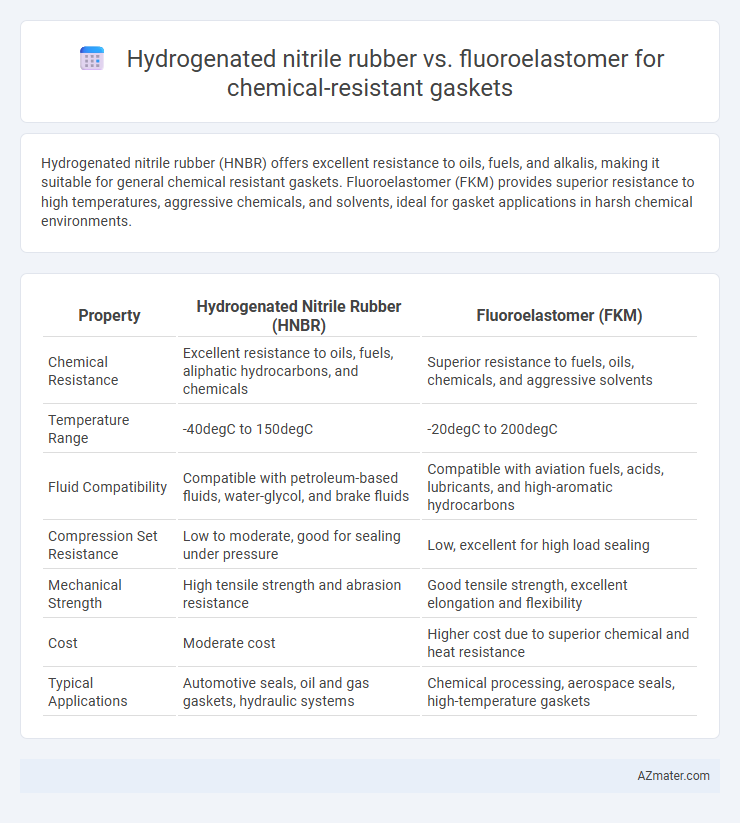Hydrogenated nitrile rubber (HNBR) offers excellent resistance to oils, fuels, and alkalis, making it suitable for general chemical resistant gaskets. Fluoroelastomer (FKM) provides superior resistance to high temperatures, aggressive chemicals, and solvents, ideal for gasket applications in harsh chemical environments.
Table of Comparison
| Property | Hydrogenated Nitrile Rubber (HNBR) | Fluoroelastomer (FKM) |
|---|---|---|
| Chemical Resistance | Excellent resistance to oils, fuels, aliphatic hydrocarbons, and chemicals | Superior resistance to fuels, oils, chemicals, and aggressive solvents |
| Temperature Range | -40degC to 150degC | -20degC to 200degC |
| Fluid Compatibility | Compatible with petroleum-based fluids, water-glycol, and brake fluids | Compatible with aviation fuels, acids, lubricants, and high-aromatic hydrocarbons |
| Compression Set Resistance | Low to moderate, good for sealing under pressure | Low, excellent for high load sealing |
| Mechanical Strength | High tensile strength and abrasion resistance | Good tensile strength, excellent elongation and flexibility |
| Cost | Moderate cost | Higher cost due to superior chemical and heat resistance |
| Typical Applications | Automotive seals, oil and gas gaskets, hydraulic systems | Chemical processing, aerospace seals, high-temperature gaskets |
Introduction to Chemical Resistant Gaskets
Chemical resistant gaskets are essential components designed to prevent leaks and ensure the integrity of systems exposed to aggressive chemicals. Hydrogenated nitrile rubber (HNBR) offers excellent resistance to oils, fuels, and many chemicals, featuring enhanced temperature stability and durability. Fluoroelastomers (FKM) provide superior chemical resistance against a broader range of solvents, acids, and hydrocarbons, making them ideal for high-performance sealing applications in harsh chemical environments.
Overview of Hydrogenated Nitrile Rubber (HNBR)
Hydrogenated Nitrile Rubber (HNBR) is a synthetic elastomer known for its superior chemical resistance, high tensile strength, and excellent heat and ozone stability, making it ideal for chemical resistant gaskets. HNBR outperforms standard nitrile rubber due to its hydrogenation process, which enhances resistance to oils, fuels, and chemicals commonly encountered in industrial applications. Its ability to maintain elasticity in temperatures ranging from -40degC to 150degC makes HNBR a preferred choice for sealing solutions requiring durability and resilience in aggressive chemical environments.
Overview of Fluoroelastomer (FKM)
Fluoroelastomer (FKM) gaskets offer superior chemical resistance, particularly against hydrocarbons, oils, and aggressive chemicals, making them ideal for demanding industrial applications. Their high-temperature tolerance up to 250degC and excellent resistance to oxidative and ozone degradation enhance durability and lifecycle performance. Compared to hydrogenated nitrile rubber (HNBR), FKM provides enhanced sealing reliability in harsh environments where exposure to solvents and acids is frequent.
Key Chemical Resistance Properties of HNBR
Hydrogenated nitrile rubber (HNBR) exhibits superior resistance to hydrocarbons, oils, fuels, and certain chemicals like ketones and alcohols, making it ideal for gasket applications exposed to aggressive petroleum-based fluids. Its enhanced hydrogenation process improves thermal stability and ozone resistance compared to traditional NBR, maintaining elasticity in temperatures ranging from -40degC to 150degC. While fluoroelastomers offer broader chemical resistance, especially against strong acids and solvents, HNBR provides excellent balance of chemical resistance, mechanical strength, and cost efficiency for medium-demand chemical gasket sealing.
Key Chemical Resistance Properties of FKM
Fluoroelastomer (FKM) exhibits superior resistance to a wide range of chemicals including hydrocarbons, oils, acids, and alkalis, making it ideal for chemical resistant gaskets in aggressive environments. Its molecular structure provides exceptional stability against high temperatures and oxidative degradation compared to Hydrogenated Nitrile Rubber (HNBR). FKM's low permeability to gases and excellent swelling resistance enhance gasket longevity and sealing performance in demanding chemical applications.
Temperature Stability: HNBR vs Fluoroelastomer
Hydrogenated nitrile rubber (HNBR) offers excellent temperature stability typically ranging from -40degC to 150degC, making it suitable for moderate high-temperature chemical resistant gasket applications. Fluoroelastomers provide superior temperature resistance, maintaining stability from -26degC up to 200degC or higher, which makes them ideal for extreme high-temperature environments. The choice between HNBR and fluoroelastomer depends on the required temperature range and the specific chemical exposure conditions in gasket applications.
Mechanical Strength and Durability Comparison
Hydrogenated nitrile rubber (HNBR) exhibits superior mechanical strength with high tensile strength and excellent abrasion resistance, making it ideal for dynamic sealing applications. Fluoroelastomers (FKM) offer excellent chemical resistance and thermal stability but generally possess lower tensile strength and elongation compared to HNBR. When prioritizing durability under mechanical stress and wear, HNBR outperforms FKM, whereas FKM excels in resisting aggressive chemicals and high-temperature degradation.
Cost and Availability Factors
Hydrogenated nitrile rubber (HNBR) gaskets offer a cost-effective solution with broader availability due to the widespread production and established supply chain of HNBR materials. Fluoroelastomer (FKM) gaskets, while providing superior chemical resistance and higher temperature tolerance, typically come at a significantly higher price point and have more limited availability in specialized grades. Companies often choose HNBR for cost-sensitive projects requiring moderate chemical exposure, whereas FKM is preferred in high-performance applications despite increased procurement costs.
Typical Applications in Industrial Environments
Hydrogenated nitrile rubber (HNBR) is widely used for chemical resistant gaskets in automotive fuel systems, oil drilling equipment, and industrial hoses due to its exceptional resistance to fuels, oils, and high temperatures. Fluoroelastomer (FKM) gaskets are preferred in chemical processing plants, aerospace, and pharmaceutical industries where superior resistance to aggressive chemicals, solvents, and extreme temperatures is required. Both materials offer robust sealing performance, but FKM excels in harsh chemical environments while HNBR provides cost-effective durability in hydrocarbon-rich applications.
Choosing the Right Gasket Material for Chemical Resistance
Hydrogenated nitrile rubber (HNBR) offers excellent resistance to oils, fuels, and aliphatic hydrocarbons, making it ideal for chemical-resistant gaskets exposed to aggressive automotive and industrial fluids. Fluoroelastomers (FKM) provide superior chemical resistance to a wide spectrum of chemicals, including acids, solvents, and high-temperature fluids, ensuring gasket integrity in harsh chemical processing environments. Selecting the right gasket material depends on the specific chemicals encountered, operating temperature, and required mechanical properties to maximize gasket performance and longevity.

Infographic: Hydrogenated nitrile rubber vs Fluoroelastomer for Chemical resistant gasket
 azmater.com
azmater.com